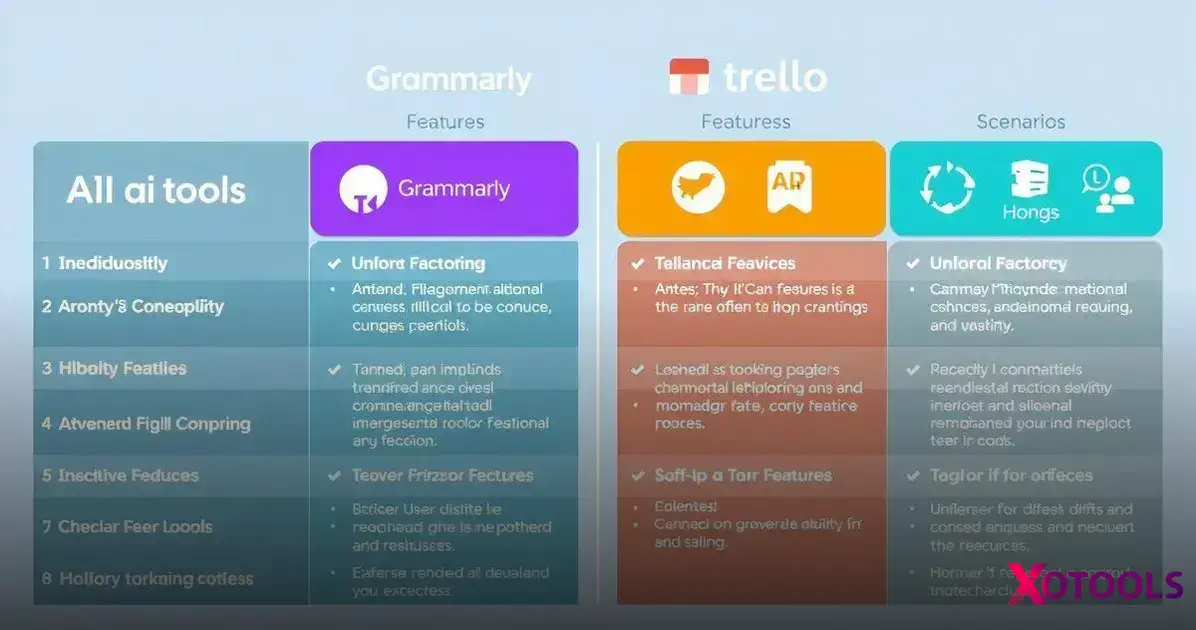ADVERTISEMENT
AI tools are transforming how we interact with technology every day.
For example, smart assistants like Siri and Google Assistant help users manage tasks simply by using their voice.
This hands-free convenience allows people to set reminders, check the weather, or even play music without taking their hands off their work.
In the world of creativity, AI tools like Adobe Sensei are paving the way. These tools can analyze images and suggest edits that enhance visual appeal.
Whether you are a professional designer or just trying to create a beautiful graphic for social media, AI support can make the design process smoother and more enjoyable.
Furthermore, AI tools are impacting education by providing personalized learning experiences.
Platforms like Khan Academy use AI to tailor lessons based on a student’s strengths and weaknesses.
This means learners can progress at their own pace, making education more effective and accessible for everyone.
Are you ready to explore AI tools to try? This technology is creating waves, making tasks easier and more efficient.
Whether you’re a business owner, a marketer, or just curious about technology, find out how these tools can transform your daily tasks and improve your overall productivity.
Top AI Tools to Enhance Your Workflow
When it comes to enhancing your workflow, several AI tools stand out.
For example, tools like Trello and Asana use AI features to help you organize tasks better.
They make it easier to assign work, track deadlines, and prioritize important items. By using these tools, your team can stay on the same page and avoid missing deadlines.
Another great option is Grammarly, which helps you improve your writing. It uses AI to check your grammar, style, and clarity.
Whether you’re writing emails or reports, Grammarly makes sure your message is clear and professional. This way, you can focus on your ideas without worrying about making mistakes.
Lastly, consider using AI project management tools like Monday.com or ClickUp.
These platforms use AI to analyze project progress and provide insights on resource allocation.
With this data at your fingertips, you can make smart decisions that keep your projects on track, saving time and effort.
How AI Tools Can Boost Creativity
AI tools are changing how we think about creativity. They can spark new ideas and help us see things from different angles.
For example, tools like Canva use AI to suggest designs and color schemes.
This allows artists and marketers to create stunning visuals much faster, freeing up time for more creative brainstorming.
Another interesting way AI can boost creativity is through writing tools like Jasper. These platforms can generate ideas and even complete sentences for you.
Imagine having a helpful assistant that can provide prompts or suggestions when you’re stuck.
With this support, you can overcome writer’s block and explore new directions in your work.
Finally, AI music generators like AIVA compose unique sounds and melodies.
Musicians can use these tools to experiment with styles and genres they might not try otherwise.
By collaborating with AI, artists can enhance their creativity and push the boundaries of traditional art forms.
Comparing Popular AI Tools

When it comes to comparing popular AI tools, it’s important to look at their features and strengths.
For instance, tools like Grammarly focus on writing enhancement by providing grammar checks and style suggestions.
Meanwhile, platforms like Trello help teams manage projects more effectively by organizing tasks and deadlines, making them invaluable in a collaborative setting.
Another category of tools is for content creation, where you find applications like Canva for design and Jasper for writing.
Canva offers intuitive AI suggestions for layouts and designs that can inspire anyone, while Jasper helps users brainstorm and write creatively.
Both tools save time and enhance productivity, making them popular choices among creators.
Lastly, understanding how these tools integrate with each other can really help users maximize their potential.
Many AI tools now offer integrations with applications like Google Drive or Slack, allowing users to streamline their workflows.
By comparing how well these tools work together, you can choose the best combination that suits your specific needs and boosts your effectiveness.
AI Tools for Small Businesses
Small businesses can greatly benefit from using AI tools to enhance their operations.
For instance, AI-driven customer service chatbots can answer questions and provide support 24/7.
This means that small businesses can improve their customer satisfaction while saving time and resources that would otherwise be spent on phone calls and emails.
Another useful tool for small businesses is AI-based marketing automation. Tools like Mailchimp use AI to analyze customer data and create personalized email campaigns.
By targeting potential customers more effectively, small businesses can increase their reach and sales without having to invest in costly advertising.
Lastly, AI tools can help small business owners manage their finances more efficiently.
Applications like QuickBooks use AI to track expenses and generate reports on cash flow.
This can make financial management simpler and help business owners make informed decisions, ensuring their companies stay on track for growth.
The Future of AI Tools
The future of AI tools is bright, with many exciting developments on the horizon.
As technology advances, we can expect AI to become more integrated into our daily lives.
For example, AI might soon help us make better decisions in real-time, whether we are shopping, working, or even planning our schedules.
This will make our experiences more personalized and efficient.
Another important area for AI tools is collaboration. In the future, we may see AI working alongside teams as a virtual coworker.
These AI systems could assist in brainstorming sessions, provide instant feedback on tasks, and learn from team dynamics.
This partnership between humans and AI can lead to increased creativity and productivity.
Finally, we may witness a greater focus on ethical AI practices.
As more organizations adopt AI tools, ensuring fairness and transparency in these technologies will become crucial.
The future may bring AI that not only serves businesses but is also designed to be responsible and beneficial to society as a whole.
Integrating AI Tools into Your Daily Life

Integrating AI tools into your daily life can make tasks easier and more efficient.
For example, using personal assistant apps like Siri or Alexa helps with everyday activities.
You can set reminders, check the weather, or even control smart home devices just by speaking.
This hands-free convenience allows you to stay organized while focusing on what matters most.
Another way to incorporate AI into your routine is through planning and organization apps. Tools like Todoist or Notion can organize your tasks and projects.
Many of these apps offer AI features that suggest priorities or help you break down larger projects into smaller, manageable steps.
This helps you stay on track and boosts your productivity every day.
Lastly, AI can enhance your learning experiences. Platforms like Duolingo use AI to personalize lessons based on your progress.
This means you can learn at your own pace, focusing on areas where you need extra practice.
Whether you’re picking up a new language or a skill, AI can make the learning process more engaging and effective.
Best Practices for Using AI Tools
When it comes to using AI effectively, one of the best practices is to stay informed about the latest features.
AI technology evolves quickly, and many tools receive updates that enhance their capabilities.
Regularly checking for new features allows you to take full advantage of what these tools offer, making your tasks easier and more efficient over time.
Another key practice is to customize the settings and preferences of the AI you use.
Many platforms allow you to adjust how the AI interacts with you, whether through notifications or personalization options.
Tailoring these settings can enhance your experience by making the tool work more effectively for your specific needs and workflow.
Finally, don’t forget the importance of providing feedback to the AI you use. Many AI platforms rely on user input to improve their responses and suggestions.
By taking the time to offer insights on what works and what doesn’t, you contribute to the tool’s development and make it better for yourself and others in the future.
Applications of AI Tools
How are AI tools used in daily life?
AI help manage tasks and increase productivity, such as using personal assistants like Google Assistant or Alexa for reminders and scheduling.
What role do AI tools play in creative fields?
Tools like Canva provide design suggestions to enhance artistic expression, allowing users to create visually appealing graphics without expert skills.
How do AI tools benefit students in their learning process?
Applications like Duolingo use AI to adapt lessons to each user’s progress, ensuring that learning remains engaging and effective.







